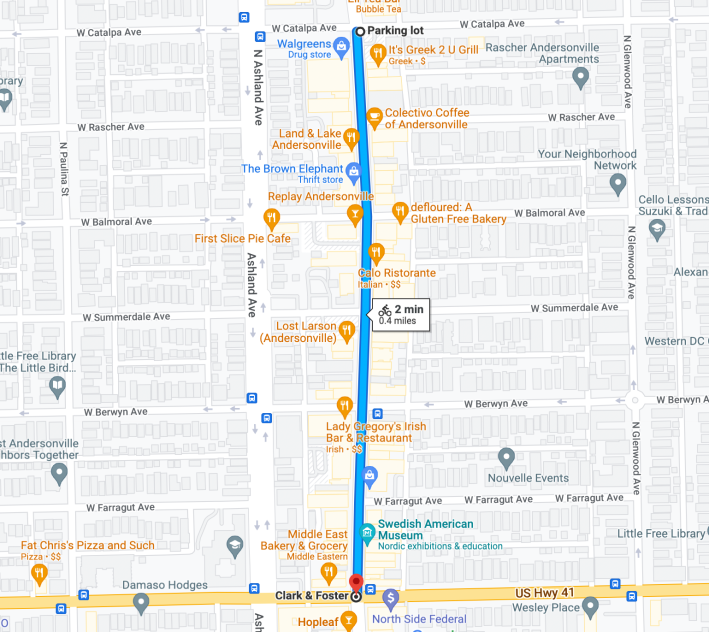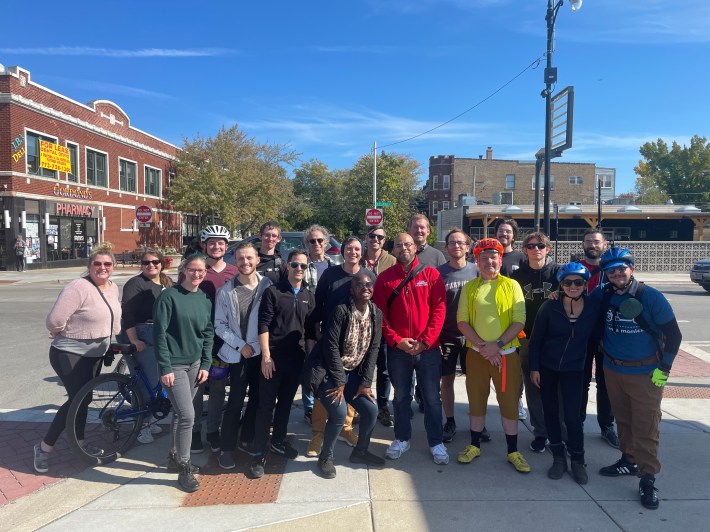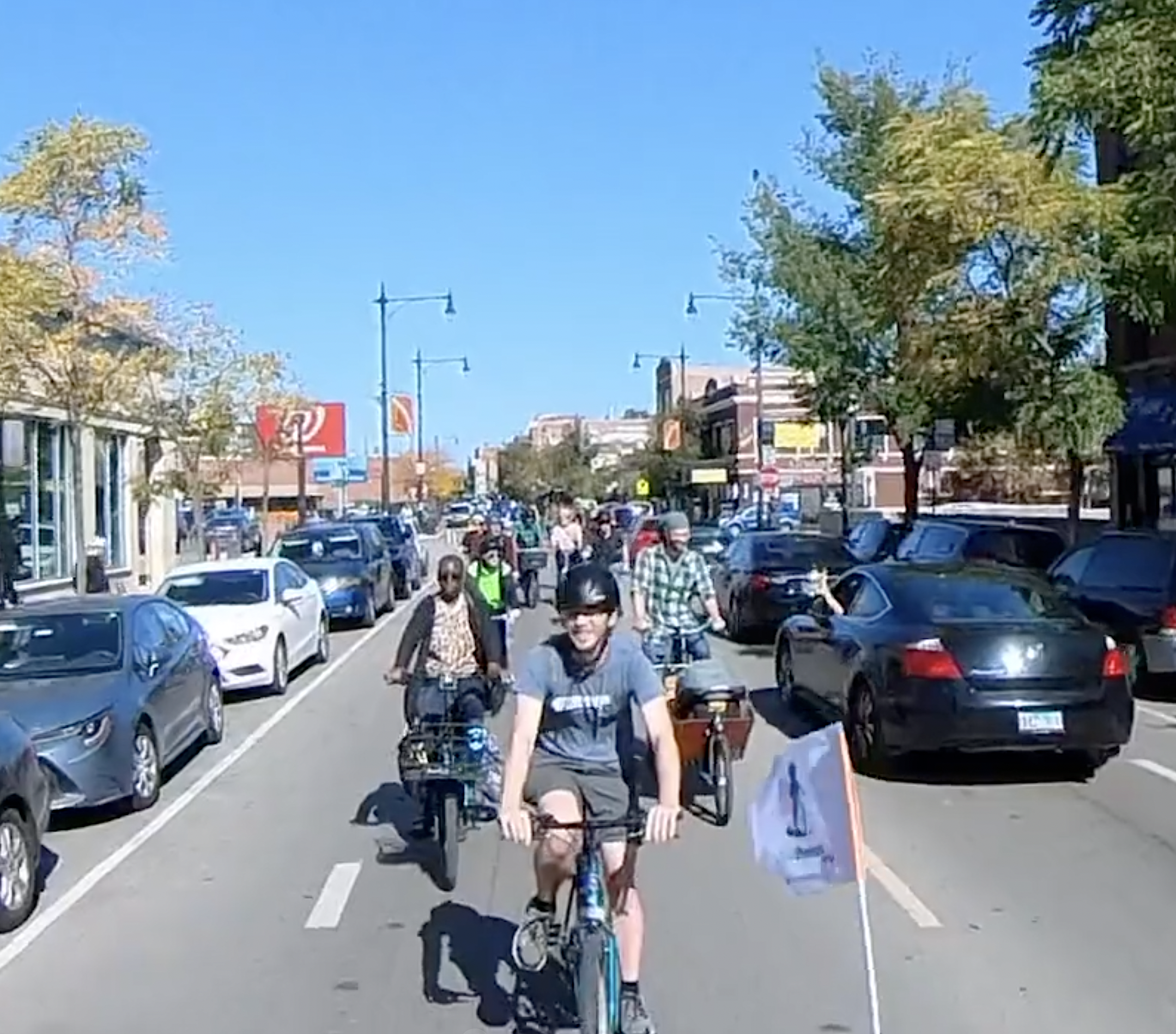I recently became aware of Chicago's new SlowStreets grassroots organization through social media and meeting founder Zak Patterson at a pedestrian and cyclist infrastructure meeting held by Ald. Matt Martin (47th.) SlowStreets is not to be confused with Slow Streets, traffic-calmed streets where motorized through traffic is prohibited so people can safely walk, bike, and play in the roadway, which the Chicago Department of Transportation piloted on handful of streets across the city during the COVID-19 pandemic.
Rather SlowStreets envisions totally car-free roadways where people walking, biking, anbd using other low-speed, sustainable modes can safely and comfortably use the street without being endangered by drivers. They're starting out with a campaign to "Open Clark Street for car-free use from Foster to Catalpa Plaza" in Andersonville.
I attended one of the group’s weekly rides in the North Side neighborhood last Saturday. Patterson said he started the organization after a scary encounter with an aggressive driver on Clark in Andersonville. He was biking with his two children in a trailer behind his bike when an aggressive driver revved their engine and came frighteningly close to striking the trailer and the kids inside.
While SlowStreets is advocating for pedestrianizing Clark between Foster Avenue (5200 N.) and Catalpa Avenue (5500 N.), where the new car-free plaza is planned, I’d love to see the car-free stretch go a bit further south and north. Either way, Andersonville is one of several Chicago retail districts where it's obvious that full pedestrianization would work. Clark is teeming with people walking around visiting various restaurants and shops. Given the amount of foot traffic in the area, the narrow sidewalk widths are inadequate, especially due to the many sidewalk cafes along the strip.

The 22 Clark bus could be routed to Ashland Avenue, about a half-block west for the length of the pedestrianized area. Some residents along Ashland north of Irving Park Road (4000 N.), the northernmost point served by the 9 Ashland bus, have previously opposed adding buses to the corridor, citing concerns about noise, exhaust and, laughably, damage to building foundations from bus vibrations. Another likely reason for the opposition is that drivers are loathe to see curbside parking spaces replaced with bus stops. But perhaps running buses on just a few blocks of Ashland wouldn't face strong resistance.
On Saturday at 11am a group of around 30 people gathered at the corner of Clark and Catalpa. The crowd was full of mostly adults but a few children rode along with their parents. After a few passionate words from Patterson about the origins of the groups, we rode a loop from Clark/Catalpa to Clark/Farragut Avenue (5230 N.) and back a few times at a very slow 6-8 mph pace, occupying the mixed-traffic lane but making sure to keep the bike lane as unobstructed as possible.
As we made our first loop, I noticed Zak was playing an announcement on a speaker explaining that the speed limit on Clark in Andersonville had recently been lowered from 25 to 20 mph, but arguing that full pedestrianization is needed to create a truly safe shopping district for people on foot and bike. A few of the riders handed out informational flyers to drivers and pedestrians alike. I was surprised to see a few drivers taking flyers. On one loop I overheard someone say, “Yeah, they do this every weekend” in a somewhat awestruck tone. It’s cool that some people are catching on.
The Clark Street jam today was a huge success!! Thanks to everyone that came out. People in front of us leisurely crossed the street from shop to shop, and many including drivers were very supportive. Thank you @Andrefor40th for coming to chat with us after! pic.twitter.com/tqfiXvrTgg
— SlowStreets - Open Clark Street for the People (@slowstreetsorg) October 9, 2022
I enjoyed the slow pace of the ride. Due to the mellow pace, I was able to take a good look at a mural I had only recently noticed while walking with a friend. I shared with one of my fellow participants that so often my rides on Clark involve being on high alert for motorists moving in and out of parking spaces, driving along the border of the dashed "advisory" bike lanes, or opening a car door in my path pedestrians. That makes it harder to notice murals or storefronts. Surprisingly, drivers who encountered the slow ride were well-behaved. Only one blurted out an expletive at the group. I heard from one of the riders that a person biking by mumbled that we were “giving cyclists a bad name” by obstructing drivers.
At the end of our ride, we were joined by local alder Andre Vasquez (40th). Zak invited Vasquez to speak about what can be done to start the process of pedestrianizing Clark. Vasquez discussed the process of getting the Catalpa plaza approved. He said he wanted to test out pedestrianizing Clark when the pandemic first began. Many business owners were wary and the idea was shot down. One key to getting support for pedestrianization from merchants is to show them data that indicates there won’t be a negative impact to their business.

In reality, the current set-up where curbside car storage is prioritized over, at the very least, least wider sidewalks with more room for comfortable walking and sidewalk dining hurts Andersonville businesses. Moreover, if walking, biking, scooting, and riding transit in the neighborhood was made safer and more convenient, without worrying so much about trying to keep driving super-convenient, people would change their transportation habits. Cities like Seattle have shown that investments in transit and safe bike infrastructure lead to higher transit and bike use.
SlowStreets is currently looking for volunteers to survey visitors to Clark Street about how they arrived, and what it would take for motorists to switch from driving to walk/bike/transit, as well as doing outreach to merchants. If you’d like to get involved, reach out to SlowStreets on Twitter, by email (in the Twitter bio) or through their website.



